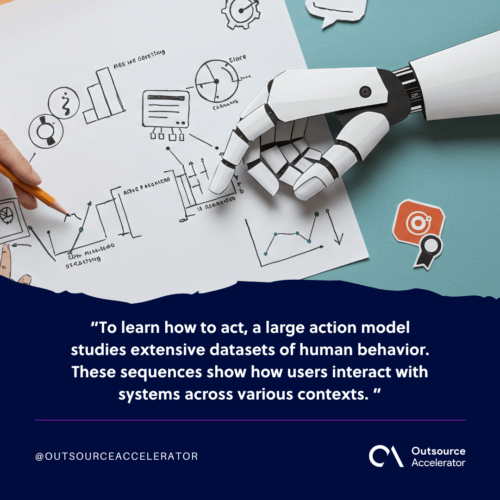Large action model (LAM): Where human intent meets real AI execution

Artificial intelligence transforms how businesses run daily operations, automating tasks, speeding up decision‑making, and elevating customer engagement.
According to Stanford University’s latest data, approximately 78% of companies now utilize AI in at least one business function. This is a sharp rise from previous years. Businesses remain eager to expand usage as AI tools evolve in capability and scope.
The Large Action Model (LAM) introduces a new paradigm where systems grasp human intent and carry out meaningful actions based on that understanding.
This article explains what a large action model adds to the AI ecosystem, reviews its key features, and discusses how it could reshape business operations.
What is a Large Action Model (LAM)?
A Large Action Model (LAM) is an advanced artificial intelligence model designed to understand human intent and convert it into meaningful actions within a system or environment.
Unlike traditional AI models that focus on language processing, a Large Action Model goes beyond generating responses; it actively performs tasks. LAMs can book appointments, manage workflows, or make decisions based on real-time data and past behavior.
They learn from vast datasets containing user actions, enabling them to adapt, plan, and respond intelligently in various contexts. This shift transforms generative AI into an active, decision-making assistant capable of handling complex tasks with minimal input.
As businesses seek more autonomy and efficiency, large action models represent the next step in AI evolution, bridging communication and execution in a way that’s both scalable and practical.

Essential features of a Large Action Model
A Large Action Model brings a new level of functionality to artificial intelligence, moving beyond passive interaction to active task execution. These core features distinguish a LAM from traditional AI models and make it uniquely capable in real-world applications:
Action-oriented design
A large action model is built to act, not just respond. Unlike language models that primarily generate text, LAMs carry out tasks, such as scheduling, controlling systems, or executing multi-step commands, within digital or physical environments.
Contextual understanding
LAMs process more than isolated instructions. They analyze surrounding data, user history, and real-time conditions to understand the full context of a request. This depth enables them to make informed and relevant decisions.
Goal-driven behavior
Each LAM is structured to work toward specific outcomes. Whether it’s completing a task, improving efficiency, or solving complex problems, the model actively moves toward achieving set objectives, often optimizing performance along the way.
These primary features give a large action model the characteristic to serve as a reliable, intelligent assistant capable of handling high-level tasks in dynamic business and operational settings.
How a Large Action Model works
A Large Action Model is a complex AI system designed not just to understand language but to convert that understanding into real-world actions.
Comparing it to traditional models that focus solely on conversation or content generation, a LAM takes the next step, executing tasks based on human intent, context, and evolving goals.
Outlined below are the fundamental processes that power this advanced tech:
Foundation of large language models
Most large action models start with the capabilities of large language models (LLMs). These models provide deep language comprehension, allowing LAMs to interpret human input accurately.
However, LAMs extend this foundation by connecting understanding with action, turning passive language into active behavior.
Powered by neuro-symbolic AI
LAMs integrate neural networks and symbolic reasoning, a combination known as neuro-symbolic AI. This hybrid approach allows them to grasp abstract concepts, apply logical rules, and plan step-by-step actions toward specific goals.
Neural components handle pattern recognition and language nuances, while symbolic systems bring structured reasoning and decision-making.
Trained on massive action-based datasets
To learn how to act, a large action model studies extensive datasets of human behavior. These sequences show how users interact with systems across various contexts.
Through pattern recognition and predictive modeling, LAMs learn to respond with relevant and effective actions tailored to specific scenarios.

Responsive in real-time environments
LAMs excel in environments that demand immediate, adaptive responses. They process live data, update their internal understanding, and adjust their actions in milliseconds.
Real-time features make them ideal for robotics, simulations, and any system where rapid decisions matter.
Together, these mechanisms allow a large action model to function as an intelligent, action-ready assistant, capable of understanding what users want and responding promptly in complex, real-world situations.
Applications of Large Action Models in daily operations
Large Action Models (LAMs) are quickly becoming valuable tools in automating and improving everyday business tasks. Their ability makes them useful across a wide range of daily operations:
- Customer support automation. LAMs can handle inquiries, resolve issues, and perform follow-up actions without human intervention, reducing wait times and improving customer satisfaction.
- Workflow management. They can schedule meetings, assign tasks, and coordinate between teams by interpreting commands and adapting to changing priorities.
- Human resource operations. LAMs assist in onboarding, leave management, and employee data updates by acting on HR-related requests in real time.
- Finance and accounting tasks. These models can process invoices, generate reports, and even flag anomalies in spending based on predefined rules and historical data.
- IT and system maintenance. LAMs monitor system performance, trigger alerts, and initiate recovery actions during failures, keeping operations smooth and responsive.
- E-commerce operations. They manage inventory, recommend product updates, and handle customer orders based on current trends and user behavior.
Large action models help businesses run more efficiently while allowing teams to focus on strategic work.
Large Action Model (LAM) FAQs
Large Action Models (LAMs) are gaining attention for their ability to bridge the gap between understanding and doing. Here are answers to some of the most common questions about them:
How are LAMs different from Large Language Models (LLMs)?
While LLMs focus on understanding and generating human-like text, LAMs go a step further. They not only interpret language but also translate that understanding into concrete actions in a given environment.
Why are LAMs important for the future of AI?
LAMs represent a shift toward more autonomous and task-oriented AI systems. As industries demand smarter automation, LAMs are expected to play a critical role in turning AI into an active decision-maker, not just a conversational assistant.
How do LAMs support automation?
LAMs learn from patterns in human behavior and system interactions. This enables them to automate repetitive tasks, respond in real time, and adapt to changes without manual intervention.
What can LAMs actually do?
LAMs can schedule tasks, manage workflows, analyze data, control systems, and make decisions based on goals and context. Their core strength lies in acting intelligently, based on both intent and environment.
As businesses seek advanced, more responsive tools, Large Action Models are poised to become essential in driving real-time decision-making and intelligent automation.







 Independent
Independent




